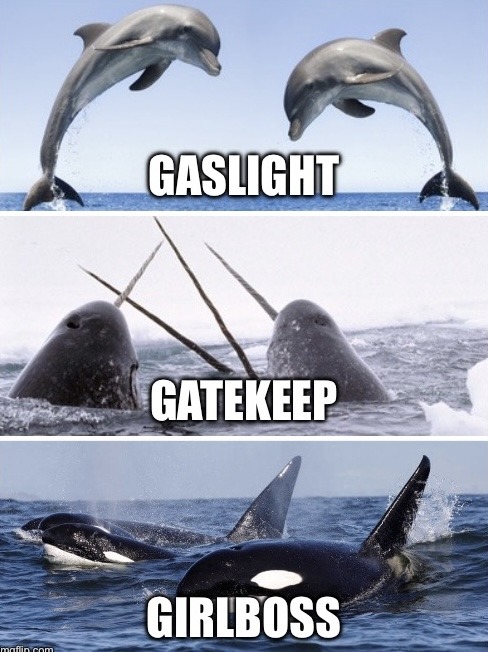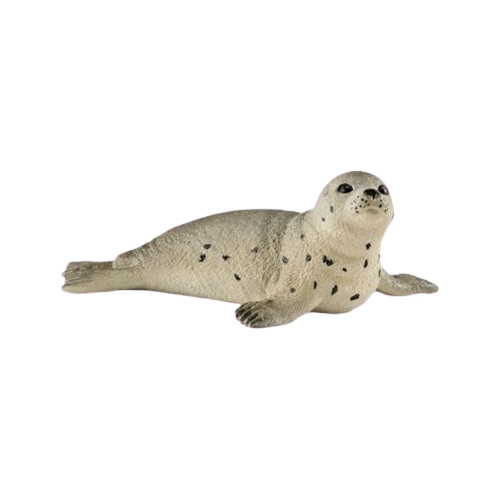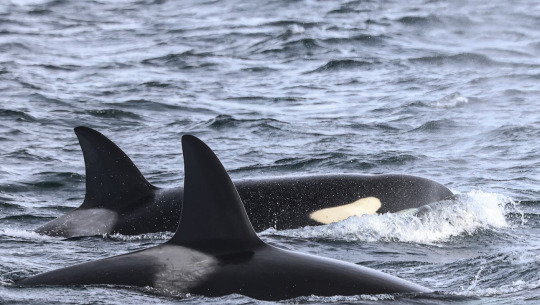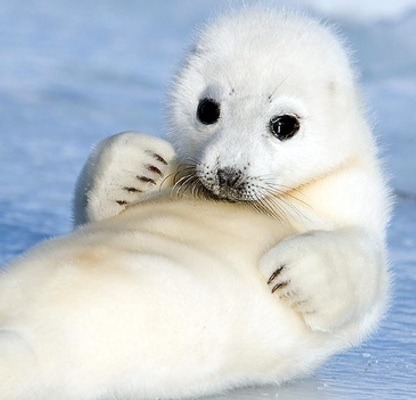#marine mammalogy
Text

gaslight, gatekeep, girlboss: cetacean edition
#marine biology#marine mammalogy#marine mammals#cetaceans#marine biology memes#cetacean memes#dolphins#bottlenose dolphin#narwhal#orca#killer whale
3K notes
·
View notes
Text






Assorted seals
-> For: @spoofaloofa (Self-indulgent)

#marine biology#marine mammalogy#moodboard pngs#cute pngs#transparent pngs#seal#seals#sea life#cute plushies#plushies#blue#ocean pngs#pngs
5 notes
·
View notes
Photo

Ribbon Seal (Histriophoca fasciata)
Family: Seal Family (Phocidae)
IUCN Conservation Status: Least Concern
Found in arctic regions of the northern Atlantic Ocean, the Ribbon Seal can be immediately distinguished from all other seals thanks to the distinctive banded fur of adults (typically black-and-white in males, while females can be black-and-white or brown-and-white), the purpose of which is something of a mystery (it has been suggested to be a form of camouflage, but how such a striking pattern would be any more effective as camouflage than the countershading seen in many other marine mammals is unclear.) Ribbon Seals spend the majority of their lives in the open ocean where they live solitary lives and feed on squids, octopuses and bony fishes such as cods, pollocks and eelpouts. During the later winter and early spring, however, large numbers of Ribbon Seals haul themselves onto masses of sea ice that are disconnected from the mainland to mate, give birth and undergo seasonal molts. During the mating season males will court females by producing grunts and roars using an inflatable sac in their throat (with each male courting and mating with several females), and after mating females are capable of delayed implantation (meaning that they can delay the development of fertilized ova until the ideal conditions to give birth in are met, in this case when sea ice is at its most abundant, to allow an embryo to develop.) After a gestation period of around 10-11 months a female Ribbon Seal will give birth to a single pup which is born with soft, fluffy white fur that (though suitable for providing camouflage and insulation) is not water tight, forcing them to remain on the ice they were born on until their adult coat develops (at which point their mother will guide them into the ocean and teach them how to hunt.)
--------------------------------------------------------------------------
Animal Advent Calendar - Day 18
Image Source: https://www.inaturalist.org/taxa/41698-Histriophoca-fasciata
#December 18th#Ribbon Seal#seal#seals#pinnipeds#mammal#mammals#zoology#biology#mammalogy#animal#animals#wildlife#marine wildlife#arctic wildlife#marine biology#if anyone figures out why they look like this let me know I'll reward you#I can't offer money or anything but I'll make a little impressed noise and that will be the reward#It'll be like Hmmm!
470 notes
·
View notes
Text

Skeletal muscle thermogenesis enables aquatic life in the smallest marine mammal
Several mammal species live in cold-water environments, enabled by adaptations such as blubber and large size. A notable exception to this rule is the sea otter, a species that is orders of magnitude smaller and skinnier than the others.
It is known that the sea otter's unusually thick fur helps, but Wright et al. show that they are also internally warmed by thermogenic leak from skeletal muscle, a process that elevates their metabolic rate three times above that expected for their size.
This mechanism is present even in infants with immature muscles, providing these animals with internal warmth from birth...
Read more:
https://www.science.org/doi/10.1126/science.abf4557
18 notes
·
View notes
Text

#Aldemaro Romero Jr.'s Letters from Academia#33. Memorial to Peter Artedi. While writing an article about the history of marine mammalogy#I went to Amsterdam#where a memorial is dedicated to the Swedish naturalist Peter Artedi (1705-1735). He is considered the father of ichthyology. This monument#look at my article at: https://www.aromerojr.net/Publications/671.When_whales_became_mammals_the_scientific_journey_of_cetaceans_from_fish_
0 notes
Text

🚨 A team of scientists, led by Phil Morin of NOAA, have published a new paper formally proposing two “new” species of killer whale: Bigg’s killer whales (Orcinus rectipinna) and resident killer whales (Orcinus ater).🚨
More than fifty years ago, researchers began studying the killer whales found off the west coast of North America. One keen-eyed scientist, Dr. Michael Bigg, noticed that there appeared to be two kinds of killer whales: a smaller, more gregarious form that fed on fish and a larger, stealthier type that fed on marine mammals. He and his colleagues dubbed the fish-eaters “resident” killer whales and the mammal-eaters “transient” killer whales (who were later renamed Bigg’s killer whales in his honor).
Two female Bigg’s killer whales in Washington (top) and a male and female resident killer whale in Alaska (bottom)


Many decades later, scientists have been hard at work trying to resolve whether or not these two forms are different species. It is not an easy task. This requires a thorough investigation into many factors, including evolutionary history, genetics, morphology, ecology, and behavior. In this paper, the researchers lay out all of the evidence and conclude that these two forms warrant elevation to species status.
As newly proposed species, both need new scientific names. There have been numerous killer whale species proposed and described in the past by other naturalists and researchers, including those in the North Pacific. Unfortunately, there are no type specimens— individual specimens upon which the first descriptions of a species are based—available for killer whales previously described from the North Pacific, so the researchers were left to examine drawings and illustrations of killer whales in the North Pacific in the late 1800s by Scammon and Cope.
The authors propose “Orcinus rectipinnus” for Bigg’s killer whales and “Orcinus ater” for resident killer whales. “Rectipinnus” presumably refers to tall dorsal fins, and “ater” means “black” or “dark” in Latin. Of note is the fact that a female killer whale from California originally examined and described by Scammon as “Orcinus rectipinnus” had seals in her stomach, suggesting she was a Bigg’s killer whale.
In addition, the authors note they are consulting with Indigenous tribes for a new common name for resident killer whales.
What’s next? In marine mammal biology, proposed taxonomic changes are reviewed by the Society for Marine Mammalogy’s taxonomy committee. If accepted, these species revisions become “official.” This has been an eagerly awaited paper by many in the field of killer whale biology and it is a great accomplishment, made possible by decades of research by scientists around the world.
A big thank you to lead author Phil Morin for letting me preview the manuscript and for answering my numerous questions in preparation for this post!
Read the paper here!
#killer whale#orca#science communication#marine biology#marine mammal#cetaceans#marine mammals#orcas#whales
536 notes
·
View notes
Note
hi hello!!! ur last post with the baby seal tagged harp seal, is actually a baikal seal!!! if i remember correctly, that’s nico from the toba aquarium (aka, the seal who was forced to eat cement when he was 6) as a young’un. they generally have bigger eyes and flatter faces than harp seals
Thank you for letting me know! Marine mammalogy is not my strongest length of knowledge.


I see now these babies have much larger eyes and the flatter face as you mentioned!
Harp Seal image below for anyone who was also confused! ⬇️

186 notes
·
View notes
Text
I have an interview with the marine mammalogy professor today and I am SO nervous to meet them I'm dying
28 notes
·
View notes
Text
I caught a Hallmark movie today titled A Splash of Love. It’s about a scientist of marine mammalogy who takes a working vacation to the pacific northwest to study orcas and of course she meets a handsome local who, what do you know, runs whale watching tours and helps her track down pods to observe in her research. There were nautical flags all over the B&B she stayed at, there was kayaking, and a whale museum! and one of the locations was called Deception Channel. Really the only things missing were a lighthouse, endless clam chowder access, and a scavenger hunt planted by a hermit lady.
27 notes
·
View notes
Photo

Chloe (Rhiannon Fish) is halfway through her PhD program in marine mammalogy (the study of whales) at one of Miami’s top universities. She pulls long hours at the lab, but what she loves most is being out on the water with the majestic creatures. But given her competitive field, she doesn't get that opportunity as much as she’d like. At the top of her class, she is considering applying for a highly sought-after scholarship that would fund the last two years of her doctorate. Dr. Andrea Ware (Madeleine Kelders) Chloe’s mentor, who encourages her to go beyond their local waters. Dr. Ware convinces her to expand her studies to cover whales in the Pacific Northwest, where she would gain more experience out in the field, and hopefully the confidence to apply for the scholarship. While there, Chloe meets a whale watching tour guide (Benjamin Hollingsworth) and they soon find themselves bonding over more than just Orcas.
9 notes
·
View notes
Text

☆ hello, i'm jin/candy.
☆ i love anything related to horror, i am currently in love with cronenberg body horror.
☆ my main fandom rn is ateez, but i'm also into genshin impact, re-animator & mary shelley's frankenstein.
☆ i'm a fic writer & an artist.

☆ interested in computer science : computer graphics, programming language, and game development.
☆ additionally i'm also interested in marine biology, particularly marine mammalogy.
☆ lots of OCs.
☆ autism is stored in the gender.

3 notes
·
View notes
Note
Bun!! We're learning about marine mammal senses in my marine mammalogy class and tbh, I think Matt is a seal. Blind seals do fine because their senses are so fine-tuned they can find food ~🦈
SEALS ARE SO CUTE PLEASE 😭😭😭😭
2 notes
·
View notes
Text
hello I am marinemammalposter I post + reblog marine mammals and occasionally other critters
Tag system:
#pinnipedia- pinnipeds (seals, sea lions, walrus)
#mystecetis- bayleen whales (most whales you think of when you hear 'whale' are this)
#odontocetes- toothed whales (dolphins, orcas, sperm whales)
#sirenia- all sirenia animals (manatee and dugong)
#mustelidae- just otters 🦦
#ursidae- polar bears (and occasionally other bears)
#other marine- any other marine critter that isn't a mammal
#other- any other animal that isn't a marine mammal
favorite animals:
-Harp seal, ribbon seal, walrus
most interested in:
-how intersexness presents in animal species, differences in male and female animals appearances, gyandromorphs
other info + boundaries:
Please try avoiding reblogging my posts adding the word 'hermaphrodite' unless it's just a tag or has been present in the conversation from the beginning/I'm directly asking questions about hermaphroditism !! If you break this it's totally ok, it's just something I'd prefer people to try and do
No dni, this is just silly animal posting :3
Account run by someone who isn't an expert in the mammalogy and biology fields yet! I may get some things wrong, please feel free to tell me if I do so I can correct them!!!
0 notes
Photo


Bowhead Whale (Balaena mysticetus)
Family: Right Whale Family (Balaenidae)
IUCN Conservation Status: Least Concern
Named for its extremely large, bow-shaped head (which can be used to smash through thin sea ice when surfacing to breathe), the Bowhead Whale can grow to be 15-18 meters (50-60ft) long, may weigh over 54,500 kg (120,000lbs) and is believed to have the potential to live for over 200 years (quite possibly the longest lifespan of any mammal.) Native to arctic and sub-arctic oceans, it feeds on plankton and other small invertebrates which it filters from the water using the comb-like baleen plates in its mouth; its extremely long baleen plates (around 4 meters/13ft in length, longer than those of any other whale) and enormous head (which makes up around 1/3rd of its total body length and features the largest mouth of any animal, opening to be around 3.7 meters/12ft high and 2.4 meters/8ft wide) make it one of the most efficient filter-feeders on earth, allowing an adult Bowhead Whale to consume around 2 tonnes of prey each day. In comparison to other whales Bowhead Whales are not particularly social and typically live alone or in small groups of 3-6 individuals, although during migration they may gather in larger numbers, and as they are not particularly aggressive towards other members of their species it is not unusual for several unassociated individuals to gather together in particularly plankton-rich areas when feeding. Bowhead Whales migrate south to relatively warm subarctic waters during the arctic winter to avoid becoming trapped beneath sea-ice that is too thick for them to break through, and while they may mate at any time of year they typically give birth while migrating back to the arctic in the spring, producing a single calf every 3-4 years after a gestation period of 13-14 months (with calves already being around 4 meters/13ft long and weighing over 900kg/2000lbs at birth.) The enormous size of this species means that it has only one natural predator (the Orca), but historically humans have hunted Bowheads extensively for their meat, bones, blubber and baleen. Commercial whaling once brought Bowhead Whales to the brink of extinction, but throughout the 1970s the practice of hunting this species was near-universally outlawed (with the only exceptions being made for two indigenous communities in Siberia and Alaska who hunt members of this species for subsistence on such a small scale that they do not have a significant negative impact on the species’ overall population.) As of the time of writing this, the IUCN believes that the numbers of several local populations of Bowhead Whales have stabilized and begun to recover from the damage done by commercial whaling, with the species’ overall global population numbers actively increasing.
--------------------------------------------------------------------------
Animal Advent Calendar - Day 23
Image Source: https://www.inaturalist.org/taxa/74103-Balaena-mysticetus
#December 23rd#Bowhead Whale#Whale#Whales#mammal#mammals#zoolog#biology#mammalogy#marine biology#marine animals#marine wildlife#arctic wildlife#wildlife#marine mammal#baleen whale#baleen whales#Bowhead whales
197 notes
·
View notes
Note
for shark ask game 1 & 4
!!
1.) Whats your favorite shark
Hammerheads by far, they're just so...shaped <3. I find the fact that sharks use electroreceptors to hunt super interesting, and hammerheads have an advantage to hunting because their larger, wider head-shape makes them excellent at it and I just think it's so neat. The great hammerhead is my favourite of the hammerhead group, but I also think Bonnetheads are cute. Honourable mentions go to nurse sharks, whale sharks, great white sharks, greenland sharks, thresher sharks, basking sharks, mako sharks, leopard sharks, and salmon sharks, so you don't just get my #1 favourite you get my top 10 LOL
4.) Are you interested in other marine animals or just sharks?
I am so interested in so many marine animals. Crabs, sea horses, nudibranchs my BELOVED... moray eels, polar bears <3, marine iguanas, tardigrades.. sea turtles...orcas...whales <3 and cetaceans in general. Lobsters, rays, octopus...gosh, isopods, squids... deep sea creatures, angler fish, giant squid (love cephalopods!), marine arthropods in general (arthropods both in sea and on land just tend to be super cool) ancient long-dead species like the helicoprion & megalodon (yes I know that's a shark)- and not just the animals but the ocean environments too, particularly the Galapagos islands, the arctic circle, coral reefs & the deep sea. Marine mammals too, love marine mammalogy, ichthyology- all of it. I'm just interested in all of it. That's the simple answer.
0 notes
Text
Welcome to my nature/wildlife blog! :) I’m Charlie, a 23 year old biology major focusing on wildlife conservation and vertebrate zoology (and minoring in environmental studies & GIS). I love the studies of herpetology (reptiles and amphibians) and mammalogy (mammals, ofc); this is just a little happy place for me lol. Check out this list to see what I focus on the most! ^_^
I add a lot of tags, mostly bc I’m forgetful & like cataloguing shit, but here are ones I try to actually remember:
#chiroptera (bats)
#trail cam
#places (non-animal or landscape stuff)
#art (including ceramics)
#plush (stuffed animals…they get me sometimes. I love cute stuff!!)
#herps (herpetology/herpetofauna, but I usually tag that too lol)
#babies (young/baby animals ofc)
#🖤 (melanistic)
#🤍 (albino/leucistic)
#canidae (sometimes..)
#hooved (hoof mammals obvi🦌)
#doggy (domestic dogs)
#piebald
#mycology #fungi AND #mushrooms…….
#domestic (pets incl. ‘livestock’)
#marine (broadly marinebio focused stuff)
#ornithology (birds)
#soops (new marsupial tag)
And #cervidae :) usually also tagged as hooved but sometimes I forget hehe. I LOVE deer
#chiroptera#canidae#ornithology#cervidae#herpetology#babies#domestic#places#art#plush#pets#trail cam#piebald#marine#herps#doggy#mycology#fungi#mushrooms#college#nature#landscape#rodentia#deer#wolves#bats#canine#cats#canis#animals
0 notes